|
Home
Articles
Search
Enroll
Equipment
Mello Chest
Souvies
Links
Updates

click her
|
Curry CCaps
|
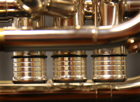
|
Curry CCaps
Rating:  |
Technical Data
From the Curry Web Site:
Since their introduction in 1989, CCAPS have proven to be the best
looking, best performing heavy valve cap on the market. At 1 oz. each, CCAPS
have enough mass to improve the response of any trumpet.
By adding mass to the entry and exit points on the valve section of your horn,
the trumpet's optimal resistance can be obtained. The weight of the CCAPS in the
proper position on the valve section can provide a denser, more centered sound,
along with a more stable harmonic series. Overall response and attacks are more
even throughout the range of the horn as well. Used alone or in conjunction with
the supplied shims and O-rings you can find the best combination for you.
Opinions
Curry introduced CCaps (aka "Sound Sleeves") back in
1989. These sleeves replace the stock valve caps and add mass to the "entry and
exit points on the valve section" as described by Curry's web site.
When properly applied to a trumpet, the CCaps provide a denser, more centered
sound and a stabalized harmonic series. Curry also contends overall "response
and attacks are more even throughout the range of the horn."
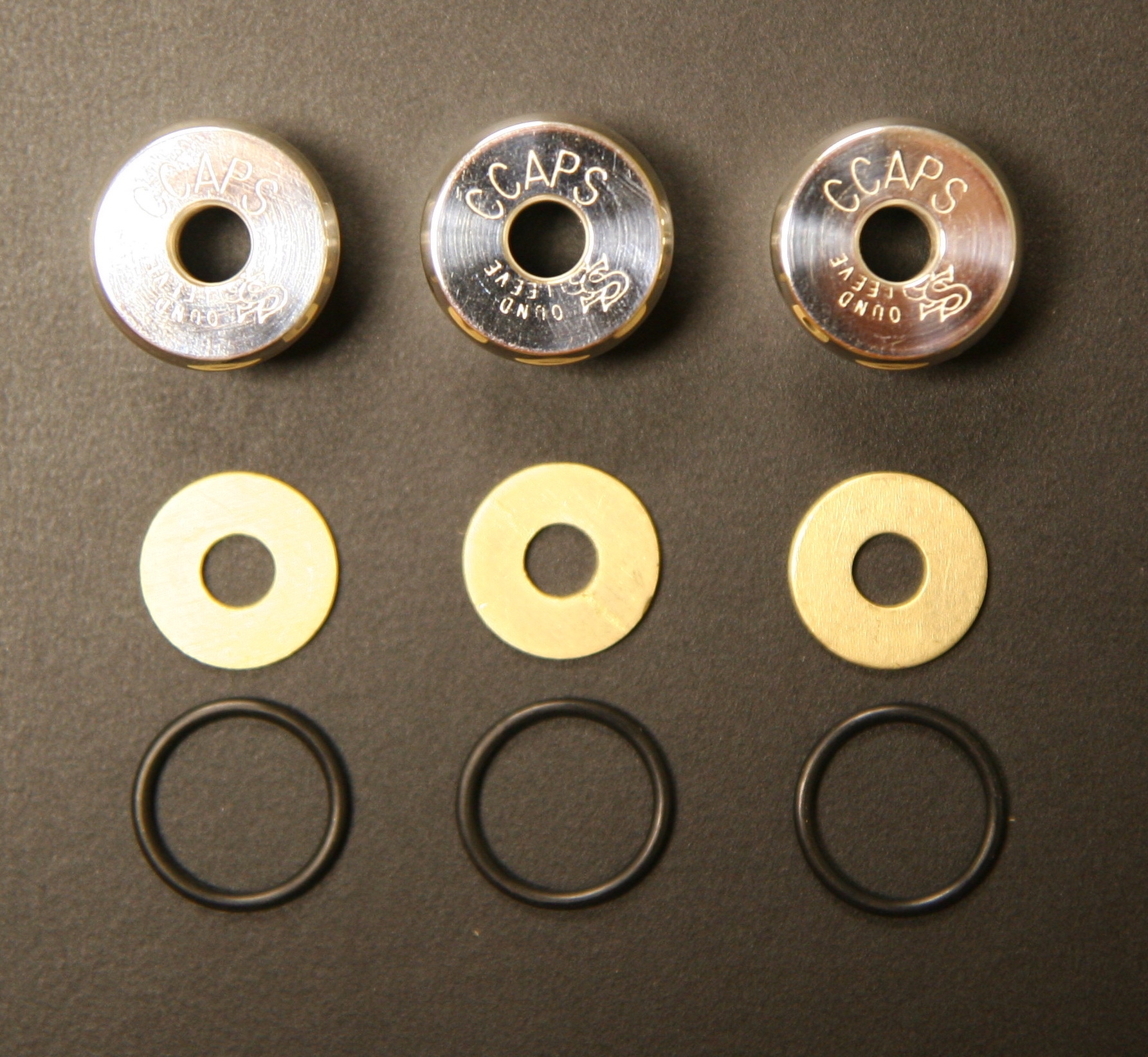
I had an opportunity to play a
Yamaha 204
mellophone owned by Jeff Freelin who had a set of
CCaps installed on the instrument. I was surprised at the amount of difference
it made to the instrument's playability when compared to the stock Yamaha 204 I
was using at the rehearsal.
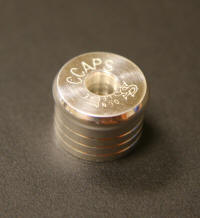
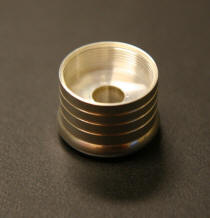
A set of CCaps were purchased to try on a Yamaha mellophone(size 1
see chart here).
The CCaps are shipped with brass shims and rubber O-rings. There are several
methods of installing these onto an instrument. Here's a listing available from
the Curry site:
1. Stretch the o-rings over the valve casing threads and screw CCAPS on. The
amount of tension can be varied on each valve. This is the darkest sounding
method. Shims are not used in this method.
2. Insert the o-ring into the CCAP and the lay the brass shim on top. This has
the effect of "grounding out" the bottom of each valve and the effects are
slightly different. Resulting sound is less dark than method #1.
3. Screw the CCAPS on as you would any other valve cap. This method retains some
of the brightness of your horn and provides some slot-lock.
4. Screw #1 and #2 on normally (no 0-rings or shims). Drop 2 shims in #3 and
screw CCAP on. This is slightly brighter than #3.
5. Any combination of #1, #2, #3, or #4. No two horns or players are alike. You
will have to experiment to see which method is best for your needs.
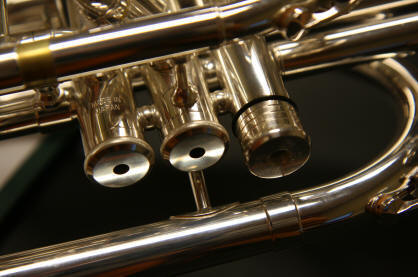 |
| The Curry CCaps for Yamaha trumpets
fits great on the Yamaha 204M Marching Mellophone with no clearance
issues. There's a lot of configuration possibilities that fit the
needs of each individual player. Some use the caps on the third
valve or third and first valve only. |
An installation was undertaken utilizing "option one" on
the Yamaha
204M mellophone. Prior experience with Monette instrumentation suggested the
best tensioning approach would be to tighten the second valve CCap the most, the
first valve slightly less tight, and the third valve as loose as possible. This
did affect the tone quality of the instrument by darkening it up. But the
instrument also responded a bit heavier with what felt like a bit more resistance.
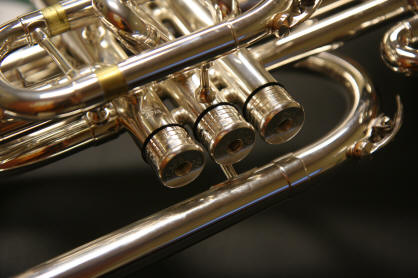 |
| installation option one incorporates
the O-rings and allows the CCaps to be tightened in varying degrees
of tension on each of the valve casings. This option results in the
"darkest" option on trumpet, but probably isn't the best option for
the mellophone. |
An email to Jeff Freelin, mellophonist extraordinaire, revealed he installed CCaps on his Yamaha 204M
mellophone utilizing option three noted above. This approach evened the overtone
series and opened up the upper register noticeably. Incidentally, Jeff
originally purchased the CCaps for the
Yamaha 203
mellophone. He found that it had a tangible impact on the high F issue
associated with this instrument.
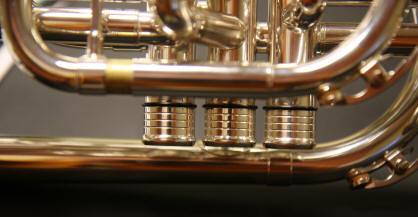 |
| CCaps offer a quick, reversible
option for the mellophone that can be adjusted to fit the needs and
tastes of nearly any performer. |
Configuration three seems to work best with the
Yamaha 204M. There's definitely a feeling of "slot lock" with the CCaps
installed without the shims or O-rings. However, I personally found the best
configuration to be installing a CCap on the third valve only (with no O-ring).
This stablizes the instrument, but still enables quick facility and no added
resistance.
Overall, these are very well-crafted and a nice, but
the individual performer will need to assess whether or note these are
indispensable for the the mellophone.
-Scooter Pirtle (email)
Where to Buy
Bob Reeves Web Site
Reader Mail
Sam Range, a mellophone enthusiast sent me this
extraordinary email on March 16, 2008 recounting his experience with the Curry
CCaps on his Yamaha 203M. I'm using the configuration he recommended and found
it to also be a great option on the Yamaha 204:
Well, after a long backorder, I have received my
valve caps and given them a fairly thorough play test, so here goes.
The first thing I tried was just screwing the caps on like the stock ones, no
shims or o-rings. I played a few notes and was a bit surprised not to notice
any difference in the sound. I fitted the o-rings on the threads and did the
same, also to no obvious difference. So, I simply left them there and started
my warm-up routine to see if I could find a difference in the playing
characteristics.
Here, there are distinct differences. I started with some scales, starting low
and incrementing higher. When I got just above the staff (I noticed this around
G or A), it was simply terrible. The notes sounded weakly, fuzzily, and were
clearly blocked. I switched back to the caps without o-rings and continued.
The scales cleared up immediately.
It was during an articulation exercise (I attached it so that you can get an
idea what's going on). It starts on a middle C and lip slurs between partials,
then puts down a valve and continues. I play this one several times, starting
slow and accelerating until it basically falls apart. I noticed that the faster
I went, the exercise managed to hold together, even playing significantly faster
than I normally do. I switched back to the stock caps to check that it wasn't
just my chops deciding to be incredible today, and it wasn't. I was simply able
to slot the notes faster with the caps, so I could move to the next note faster.
This difference was dramatic enough that I was pretty much sold on these caps.
I began experimenting with different combinations to find what worked best. I
tried the method you mentioned in the article, one cap on valve 3 with no
o-ring, but I had a hard time noticing any difference in sound or playability.
Then I tried putting caps on all 3 valves, no o-rings. The slotting was
extremely secure and there wasn't much resistance. However, doing some lyrical
playing, the slots seemed very harsh. It was difficult to play in a smooth,
legato fashion. Given that my band's show for this year includes "Concierto de
Aranjuez," with a huge lyrical mello solo, this would not be a good choice.
Side note: has this been played on the Mellocast? The Madison Scouts' 1995
recording has a significantly amazing mello solo.
So, looking to soften the slotting a bit, I tried wrapping an o-ring around each
valve block and screwing the caps on. This definitely softened the response,
but I encountered the same problems of huge resistance in the upper register. I
theorize that this is because the threads only loosely hold the cap, and the
o-ring is free to absorb vibrations. The entire thing damps vibration fairly
dramatically. I didn't notice this effect as much with the o-rings were in the
cap with shims making the contact with the bottom of the valve block.
Next, I put the o-rings in the bottom of the caps and put a shim over each one,
then screwed the entire thing on. This moderated the problems of the o-rings on
the valve block. The slot-lock was still significant, but not harsh. I kept
experimenting, trying placing two shims on top of an o-ring in the cap. This
left a gap between the cap and the valves, so I first placed an o-ring on the
valves, then screwed on the cap. This takes 2 o-rings, so it can only be done
on one valve. The o-rings seemed least significant on the second valve, so I
stole one from that valve.
This seemed most noticeable on the third valve, where it darkened the sound and
left slotting intact. It did add a bit of resistance above the staff, but only
enough that the notes couldn't be easily overblown, so no real loss there. This
combination was the best that I found. I'll lay it out, since this was fairly
unclear.
1st valve: no o-ring on the valve block. One o-ring in the base of the cap, one
shim over the o-ring.
2nd valve: no o-rings or shims at all.
3rd valve: one o-ring on the threads of the valve. One o-ring in the bottom of
the cap. Two shims over the o-ring in the cap. Tighten until the valve
contacts the shims.
I'm satisfied with this combination. It seems a good compromise between
slotting, tone, and resistance. I have noticed that nearly all combinations
using these caps seem to even out the scale. I play a yamaha 203, and this does
make the thin slot of E and F less troublesome and noticeable.
Some notes besides playing and sound, these are difficult to screw on because of
how close the ends of the valves are to the bottom of the bell wrap. You have
to unscrew the first or third cap to have any access to the second valve cap,
and even then, it can be difficult to get enough of a grip to loosen a tight
cap.
The instrument still fits in the case perfectly since the bell wrap extends
beyond ends of the cap anyway. It's probably even possible to fit Curry's
magnum caps on, though I think that would be too much mass to be practical.
When I first screw the caps on, the extra weight is noticeable. I don't think
it's enough to be problematic, even in marching situations. Also, the weight
has a bit of a twisting force, making the instrument the slightest bit
bell-heavier. I use an IYM, so the horn still balances beautifully, but if
you're using a lighter mello piece, or heaven forbid a horn mouthpiece on an
adapter, this could be irritating.
Ultimately, this was fun to play with. You can make the horn play a bit better,
and they look awesome. They're not indispensable, but they're worthwhile.
-Sam Range
|
